Gary McDonald Business Editor
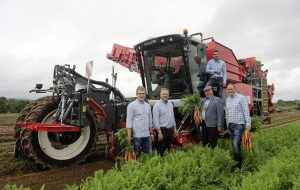
Some of the staff and pickers at work in the Gilpin farm in Armagh
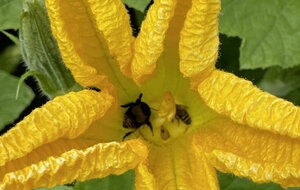
POLLINATOR: A bee inside a flower
NATURE – and the art of reproduction – is being given a helping hand in Co Armagh in a unique initiative where farmers are being assisted to track pollinators to maintain quality of produce and improve crop yields.
Retailer M&S is teaming up with agri-tech start-up AgriSound to provide in-field noise sensor technology to boost pollinator activity.
More than 70 per cent of the world’s food crops grown for human consumption rely on pollinators for sustained production, yield and quality.
And one of 18 sites across the UK chosen for the experiment is Gilpin Farms in Armagh, where sensors will be placed in its pumpkin patches.
Two in-field sensor trials were launched last year to help farmers better support pollinators like bumblebees and increase crop yields.
AgriSound technology allows farmers to track the number of pollinators visiting their farm in real-time and target specific interventions, like differing wildflower densities, for improving numbers and yields and quality of crops.
Now the technology is being scaled up across the UK to cover a diverse range of M&S’s fruit, veg and salad farms, with monitors covering 120 habitats and more than 1,000 hectares.
The technology will provide growers like Gilpins – which supplies M&S with carrots, leeks, pumpkins and Brussels sprouts – with access to real-time data and insights to help set their farms up to be more nature friendly.
Richard Gilpin, head of operations at Gilpin Farms, said: “The technology will be invaluable to help us monitor the pollinator activity across the whole farm, but particularly in the pumpkin crops.
“We currently bring in over 100 hives of bumble bees and honey bees to aid the pollination of the pumpkins, and the AgriSound technology will monitor how effective this is and also help us to make informed decisions about further interventions.
“We’re delighted to have been selected by M&S as one of the locations for this expansion and are excited to see what beneficial outcomes can be achieved by these relatively simple measures.
“If we can attract more pollinators to our farm, this will be a huge success.”
Andrew Clappen, technical director at M&S Food, added: “Improving biodiversity is at the forefront of our plans to help farmers become more resilient to the impact of climate change.
“Pollinators are the unsung heroes of farming – helping to improve yields and quality while benefitting the wider environment.”
We are here to share current happenings in the bee industry. Bee Culture gathers and shares articles published by outside sources. For more information about this specific article, please visit the original publish source: How technology is giving nature – and pollinators – a helping hand in Armagh – The Irish News
]]>Contact: Kim Kaplan
Email: Kim Kaplan
MADISON, WI,—Honey bees are more faithful to their flower patches than bumble bees when it comes to returning to collect more pollen and nectar, according to a study by U.S. Department of Agriculture Agricultural Research Service scientists.
Overall, 76 percent of honey bees in the study revisited the same plot of alfalfa flowers in contrast to just 47 percent of eastern bumble bees.
But size does matter, especially to bumble bees. They were more faithful to larger flower patches, while the likelihood of honey bees returning to a flower patch was not affected by patch size. Large patches in the study were nearly 15 by 15 yards, each planted with 225 plants, more than twice as many as the small patches, which were about 10 by 10 yards with 100 alfalfa plants each.
To remain faithful to a specific location, an insect or animal requires reliable spatial memories enabling them to navigate complex landscapes and repeatedly return to the same site. Both honey and bumble bees have demonstrated this ability to return to previously visited foraging locations, so there must be other species-specific factors to explain the differences in patch fidelity observed between the two species, explained ecologist Johanne Brunet with the ARS Vegetable Crops Research Unit in Madison, Wisconsin, who led the study along with postdoctoral associate Fabiana Fragoso.
Differences in patch fidelity could be the result of bumble bees’ more explorative foraging behavior—their willingness to invest individually in foraging, often visiting more than one type of flower per foraging bout—compared to honey bees’ more highly developed communication system—the honey bees’ well-known waggle dance. Honey bee foragers perform the dance when they return to the hive to share the location of valuable food sources with other foragers; bumble bees do not.
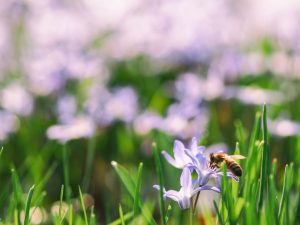
Honey bees are more faithful to their flower patches than bumble bees when it comes to returning to collect more pollen and nectar. Photo by Aaron Burden on Unsplash
“So higher patch fidelity of honey bees, relative to bumble bees, may reflect a greater aversion to risk, be it in terms of wasting energy and resources or encountering predators” Brunet said.
The better our understanding of the characteristics that drive patch fidelity in important pollinators like honey bees and bumble bees, the better beekeepers, producers and conservation biologists will be able to support pollinators health as well as uphold the essential agricultural need to have crops pollinated to produce a harvest, Brunet added.
But the implications go far beyond that. For example, the pattern of pollination can have potential impacts on gene flow, the way in which gene pools of two separate populations of the same species mix.
“Bumble bees’ lower patch fidelity can translate into higher gene flow among the patches they visit, creating a higher probability for bumble bees to move genes longer distances,” Brunet said. “Higher gene flow in plant populations in the natural environment will also tend to homogenize their genetic diversity.”
This study was published in Ecosphere [https://doi.org/10.1002/ecs2.4606]
The Agricultural Research Service is the U.S. Department of Agriculture’s chief scientific in-house research agency. Daily, ARS focuses on solutions to agricultural problems affecting America. Each dollar invested in U.S. agricultural research results in $20 of economic impact.
We are here to share current happenings in the bee industry. Bee Culture gathers and shares articles published by outside sources. For more information about this specific article, please visit the original publish source: https://doi.org/10.1002/ecs2.4606
]]>Dominant in the San Diego region, foreign honey bees visit nearly twice as many flowers as native bees
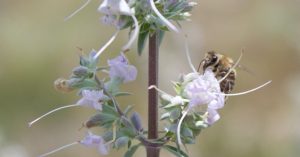
A honey bee visits white sage. Researchers have shown that pollination by honey bees, which are not native to the Americas, produces offspring of considerably inferior quality than offspring resulting from native pollinators. Credit: Dillon Travis
By:Mario Aguilera – [email protected]
With a broad mix of plant and animal species, the San Diego region is widely regarded as a global biodiversity hotspot.
As key pollinators, bees play a foundational role in the region’s floral diversity. But not all bees have the same influence on the plants they pollinate, new research from University of California San Diego scientists has revealed. Pollination by honey bees, which are not native to the Americas, produces plant offspring of considerably inferior quality (lower fitness), than offspring resulting from native pollinators, according to the study, published in Proceedings of the Royal Society B. The study is believed to be the first to directly compare offspring fitness resulting from honey bee pollination with other floral visitors.
Previous research offered evidence that predominantly feral honey bees account for more than 90 percent of the pollinators observed visiting flowers of abundantly blooming native plant species around San Diego. In their new study, School of Biological Sciences recent graduate student Dillon Travis and Professor Joshua Kohn have shown that honey bees visit approximately twice as many flowers on an individual plant before moving to the next plant, compared with native insect visitors. However, this methodical foraging behavior appears to have a detrimental effect on reproduction in the plants they visit because most of the pollen delivered to flowers will come from the same individual plant (known as self-pollination), which can lead to lower-quality offspring.
To gain perspective on the effects of such pollination dominance and propensity to visit multiple flowers on the same plant, the researchers conducted a series of experiments that evaluated the fitness of plant offspring across factors such as seed maturation, germination, survival, growth and reproduction. Using three common plant species from native habitats in San Diego County at locations that included the University of California Natural Reserve System’s Elliott Chaparral and Dawson Los Monos Canyon Reserves, the researchers assessed a variety of conditions including natural pollination, no pollination, honey bee pollination, native bee pollination and self- and cross-hand pollination.
Four to six weeks later they collected the seeds from each scenario and compared the fitness of each. Offspring resulting from pollination by native insects (mostly various species of bees), they found, were two- to five-times more fit—characterized as likely to mature into seed, germinate, grow and reproduce—than those resulting from pollination by honey bees. This seems to be the result of higher levels of self-pollen delivered by honey bees, since offspring resulting from hand pollination using pollen from the same individual plant were two- to 10-times less fit than offspring produced using pollen from a different plant of the same species.
“While honey bees are perceived as beautiful mutualists that are helping plants with reproduction, it turns out they may not be as good for plants as many native pollinators. We have found that they deliver lower-quality pollen than do native pollinators.”
— Professor Joshua Kohn
“While honey bees are perceived as beautiful mutualists that are helping plants with reproduction, it turns out they may not be as good for plants as many native pollinators,” said Kohn, a professor in the Department of Ecology, Behavior and Evolution. “We have found that they deliver lower-quality pollen than do native pollinators.”
In a related study (Travis and Kohn, in press), honey bees were shown to visit more flowers per plant than average among other pollinators across 44 different plant species, which included both crop and non-crop plants. So the foraging behavior of honey bees may regularly deliver more self-pollen, resulting in lower quality offspring.
Honey bees are the world’s most frequent floral visitor, accounting for some 13 percent of all global floral visits to native vegetation. They are native to Europe, Western Asia and Africa and were first brought to the Americas in the 17th century. San Diego is regarded as “honey bee heaven” with a higher frequency of floral visits by honey bees than nearly anywhere else in the world. The area also features more than 650 species of native bees and other pollinating insect species that interact with at least 2,400 types of plants, more than any other county in the United States.
“If honey bees generally lower seed fitness of native plants, it could make the native plant community more susceptible to invasion from introduced plant species that do not require insect pollination…” the researchers note in their paper. These introduced plants are often grasses and other invasives that help spread wildfires in these ecosystems.
“People see honey bees as providing a valuable service, which is pollination, but there’s a decent amount of evidence to show that they’re competing with native insects for resources like pollen and nectar,” said Travis, who indicated that honey bees are also known to have viruses that can be transferred to native bees. “Many conservation efforts are focused on saving the honey bee, but they are not in any danger of going extinct. In fact, their numbers have been increasing. The organisms that do need our help are the native plants and bees.”
We are here to share current happenings in the bee industry. Bee Culture gathers and shares articles published by outside sources. For more information about this specific article, please visit the original publish source: Plants Pollinated by Honey Bees Produce Lower-quality Offspring (ucsd.edu)
The study was funded by the Sea and Sage Audubon Society, the Messier Family Fund and a UC Multicampus Research Program grant.
]]>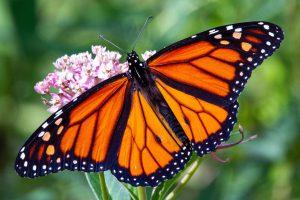
Photo by Joshua J. Cotten on Unsplash
If you’ve ever wondered how the monarch butterfly got its spots, University of Georgia researchers may have just found the answer.
The new study suggests that the butterflies with more white spots are more successful at reaching their long-distance wintering destination. Although it’s not yet clear how the spots aid the species’ migration, it’s possible that the spots change airflow patterns around their wings.
“We undertook this project to learn how such a small animal can make such a successful long-distance flight,” said lead author Andy Davis, an assistant researcher in UGA’s Odum School of Ecology. “We actually went into this thinking that monarchs with more dark wings would be more successful at migrating because dark surfaces can improve flight efficiency. But we found the opposite.”
The monarchs with less black on their wings and more white spots were the ones that made it to their ultimate destination, nearly 3,000 miles away in south and central Mexico.
“It’s the white spots that seem to be the difference maker,” Davis said.
Migration selects for butterfly spots
The researchers analyzed nearly 400 wild monarch wings collected at different stages of their journey, measuring their color proportions. They found the successful migrant monarchs had about 3% less black and 3% more white on their wings.
An additional analysis of museum specimens that included monarchs and six other butterfly species showed that the monarchs had significantly larger white spots than their nonmigratory cousins.
The only other species that came close to having the same proportion of white spots on its wing was its semi-migratory relative, the southern monarch.
Monarchs use solar energy to improve flight
The authors believe the butterflies’ coloring is related to the amount of radiation they receive during their journey. The monarchs’ longer journey means they’re exposed to more sunlight. As a result, they have evolved to have more white spots.
“The amount of solar energy monarchs are receiving along their journey is extreme, especially since they fly with their wings spread open most of the time,” Davis said. “After making this migration for thousands of years, they figured out a way to capitalize on that solar energy to improve their aerial efficiency.”
But as temperatures continue to rise and alter the solar radiation reaching Earth’s surface, monarchs will likely have to adapt to survive, said Mostafa Hassanalian, co-author of the study and an associate professor at the New Mexico Institute of Mining and Technology.
“With greater solar intensity, some of that aerial efficiency could go away,” Davis said. “That would be yet one more thing that is hindering the species’ fall migration to Mexico.”
Monarch breeding population is stable
But it’s not all bad news for the flying insects.
Davis’ previous work showed that summer populations of monarchs have remained relatively stable over the past 25 years. That finding suggests that the species’ population growth during the summer compensates for butterfly losses due to migration, winter weather and changing environmental factors.
“The breeding population of monarchs seems fairly stable, so the biggest hurdles that the monarch population faces are in reaching their winter destination,” Davis said. “This study allows us to further understand how monarchs are successful in reaching their destination.”
We are here to share current happenings in the bee industry. Bee Culture gathers and shares articles published by outside sources. For more information about this specific article, please visit the original publish source: Monarchs’ White Spots Aid Migration – Eurasia Review
]]>By Sydney O’Shaughnessy
Pollinators including insects, birds, bats, and other animals are essential to agriculture and natural ecosystems throughout North America. About three-quarters of all flowering plant species rely on pollinators for reproduction, including important fruit, vegetable, and seed crops as well as other crops that provide fiber, medicine, and fuel. While the economic and agricultural value of pollinators is clear, these species also help to maintain the healthy functioning of a wide range of natural ecosystems. However, pollinator populations have been rapidly declining in recent years, and if this trend continues, it could put U.S. economic, agricultural, and environmental systems at risk.
The National Academies have worked for decades to develop sustainable solutions to halt pollinator decline. National Pollinator Week was designated as the third week in June by the U.S. Senate.
Why are pollinator populations declining?
The reasons vary depending on whether the pollinator is considered a wild or managed species. Wild pollinators are animals and insects native to a particular area that aid in pollination for both crops and other plants. Managed pollinators, such as imported, nonnative honeybees, are considered commercial livestock. Managed pollinators typically have larger populations than their wild counterparts, and aid in the pollination of over 90 commercially grown crops.
 Beehives in Chico, California, almond orchard to aid in the pollination of the trees in bloom. Beekeepers provide bees for pollination throughout California, which contributes over 80% to the worldwide almond market.
Beehives in Chico, California, almond orchard to aid in the pollination of the trees in bloom. Beekeepers provide bees for pollination throughout California, which contributes over 80% to the worldwide almond market.
Wild pollinators are declining because of spillover of pathogens, like parasites, bacteria, and viruses, from nearby managed populations. Excessive pesticide use, climate change, resource competition with managed pollinators, and habitat degradation and loss from human development also contribute to wild pollinator decline. Habitat degradation is especially detrimental for some wild bats, bees, and butterflies.
Despite the agricultural industry’s propping up of managed pollinators, these populations are also experiencing declines. In addition to the loss of habitat and excessive pesticide use, parasitic mites are causing managed honeybee colonies to collapse.
What is being done to conserve and restore pollinator species and communities?
Pollinator conservation and restoration solutions come from many different sources. For example, a 16-volume National Academies series examines ways transportation agencies can make a meaningful difference in pollinator habitat. The series says that state Departments of Transportation (DOTs) can manage roadside vegetation with pollinator needs and habitat in mind. By using native plant materials, for instance, DOTs can establish diverse plant communities along roadways, minimize mowing and pesticide use, provide water sources, and create pollinator habitat corridors, which is a pathway that offers contiguous habitat and forage.
 In addition, a recent report on the nation’s native seed supply says that insufficient supply of these seeds is a major barrier to ecological restoration and other revegetation projects across the United States. The report calls for concerted action to build a more robust native seed supply and industry, so that habitat restoration can be beneficial to both wild and managed pollinator populations, especially in the face of climate change.
In addition, a recent report on the nation’s native seed supply says that insufficient supply of these seeds is a major barrier to ecological restoration and other revegetation projects across the United States. The report calls for concerted action to build a more robust native seed supply and industry, so that habitat restoration can be beneficial to both wild and managed pollinator populations, especially in the face of climate change.
What can you do to help pollinators?
There are many individual actions that can be taken to help restore local pollinator populations. Get involved by:
- Building native bee houses
- Planting pollinator-friendly gardens
- Attending native plant sales
- Advocating for responsible or pesticide-free practices
- Spreading awareness on social media
We are here to share current happenings in the bee industry. Bee Culture gathers and shares articles published by outside sources. For more information about this specific article, please visit the original publish source: To Mark National Pollinator Week, National Academies Offer Sustainable Solutions to Restore and Protect Critical Species | National Academies
]]>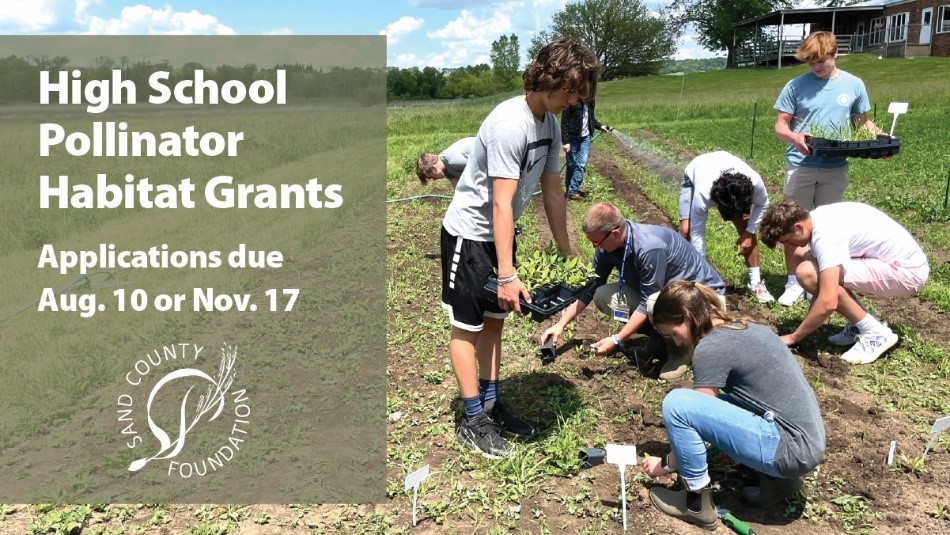 Pollinator Grants Offered to High Schools
Pollinator Grants Offered to High Schools
Sand County Foundation is now accepting applications from high school teachers for pollinator habitat grants.
This competitive grant program gives Illinois, Iowa, Michigan, Minnesota, and Wisconsin high school students hands-on experience growing native wildflowers and establishing habitat for imperiled insect pollinators and monarch butterflies.
Successful applications will receive prairie seeds and seedlings, consultation, and $1,000 to support project expenses. This year the program will make two rounds of awards, with applications deadlines of August 10 and November 17, 2023. To apply, visit www.sandcountyfoundation.org/SchoolGrants.
Insect pollinators are essential for crop pollination and ecological diversity. In recent years their populations have declined partly due to loss habitat, especially in the agricultural landscape.
“Students will germinate and grow native plants over the winter, and plant them outside in the spring as an experiential learning opportunity,” said Haley Diem, Sand County Foundation school grant program coordinator. “We encourage applicants to partner with landowners to establish pollinator habitat on agricultural and other working lands.”
Pollinator habitat grant program sponsors include: Syngenta, Enel North America, Monarch Joint Venture, and U.S. Forest Service International Programs.
“Enel understands the fundamental role pollinators play in our natural world. We’ve incorporated pollinator habitats into solar projects, recognizing that renewable energy can not only reduce carbon emissions but also support the ecosystems surrounding these projects,” said Jesse Puckett, Director of Sustainability Projects and Community Affairs for Enel North America. “We’re honored to support this important program and are grateful for the Sand County Foundation’s work to engage high schoolers in developing pollinator habitats.”
In addition to the grant program, teachers can access a Pollinator Habitat Curriculum Guide. Aligned with state and national education standards, the guide’s activities engage students in planning, establishing, managing, and monitoring prairie habitat. The guide is available for free download at https://bit.ly/2JHdq1u.
Sand County Foundation is a national non-profit that champions voluntary conservation practices by farmers and ranchers to improve soil, water, and wildlife habitat.
MEDIA CONTACT:
Casey Langan, Sand County Foundation
608.295.6001, [email protected]
We are here to share current happenings in the bee industry. Bee Culture gathers and shares articles published by outside sources. For more information about this specific article, please visit the original publish source: https://www.sandcountyfoundation.org/our-work/soil-and-water-conservation/monarch-pollinator-conservation
]]>While honey bee workers are all the same size, that’s not true for bumblebees. Scientists aren’t sure what’s behind the wide variety in bumble body sizes, but a new UC Riverside project aims to find out.
Certain crops, like greenhouse tomatoes, eggplant, peppers, and blueberries, rely on bumblebees for a style of pollination that only bumblebees can perform. Among growers, the preference can be for bigger-bodied bumblebees because they’re thought to be more efficient pollinators.
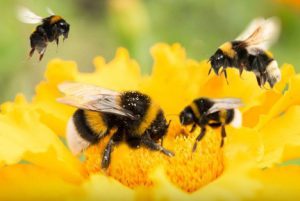 Enabled by a $750,000 grant from the National Institute of Food and Agriculture, the research team will investigate factors suspected of influencing bumblebee biology and body size, including climate change, wildfires, and the presence of nearby honey bee colonies.
Enabled by a $750,000 grant from the National Institute of Food and Agriculture, the research team will investigate factors suspected of influencing bumblebee biology and body size, including climate change, wildfires, and the presence of nearby honey bee colonies.
In many cases, individual animals are born smaller when their habitat has less nutrition available. The researchers want to know if this is also true for bees. “One idea is that honey bees are taking more food resources, resulting in smaller bumbles. This is part of what we will be testing,” said UCR entomologist and project lead Hollis Woodard.
To test this, the researchers will collect bumblebee size data over the next four years from places both with and without honeybees nearby. “It’s hard to find anywhere in the lower 48 without either managed or feral honey bees. For this reason, we’re headed to Alaska for part of the study,” Woodard said.
Fire may also play a role in bumblebee development. Some research has shown that bumblebees are born bigger, and in higher numbers, during the years following a wildfire. Since wildfires are common in California, the research team will also be collecting data from places throughout the state with different types of fire histories.
“Fires are good in some ways for bees,” Woodard said. “As the land recovers from the burn, a lot of flowers appear, offering food.”
In addition to the mystery of what influences the bees’ body size, it’s also unclear what role size plays in a bumble colony. While all bumblebee workers perform the same functions, variation in size could allow the hive as a whole to collect pollen from a wider variety of flowers.
Though bigger bees can collect more pollen, they might not be right for every plant species. For some flowers, especially those that are trumpet-shaped, smaller bumblebees are better pollinators.
“There are theories that bumblebee sizes are just random, or that it’s just generally good to have variation,” Woodard said. ‘Right now, we don’t yet know exactly what this variation in size does for colonies.”
In addition to benefitting crop growers, the team’s findings could ultimately benefit the bees themselves. “Any insights we gain into factors affecting the bumblebees could help us better understand how to bolster their dwindling populations,” Woodard said. “Helping them in turn helps ensure the health of wildflowers, as well as our food supply.”
Source: ucr.edu
We are here to share current happenings in the bee industry. Bee Culture gathers and shares articles published by outside sources. For more information about this specific article, please visit the original publish source: ucr.edu
]]>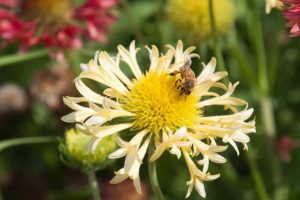
Researchers shed more light on how insects pollinated the very first flower. (KarinD/Adobe)
The Botanic Gardens of Sydney has published a paper with researchers from Macquarie University and Western Sydney University, shedding more light on one of the earliest origin stories about the birds and the bees.
A large dataset examining what pollinators are relied on by 1,160 species of different flowering plant families has been examined to determine the long relationship insects have had with some of the earliest flowers.
By examining a state-of-the-art ‘evolutionary tree’, researchers believe that insects have pollinated angiosperms, or flowering plants, over most of the plant’s 140-million-year evolution.
The findings of the botanical science study were published in the journal New Phytologist on Tuesday.
Macquarie University PhD student Ruby E. Stephens was the lead author of the paper. She explained the evolutionary tree showed when certain plant families evolved, which helped to advance the understanding of plant history.
“This is a significant discovery, revealing a key aspect of the origin of almost all plants on Earth today,” Stephens said.
“By running different models, we can map backwards from what pollinates a plant in the present, to what might have pollinated the ancestor of that plant in the past.”
A total of 90% of today’s flowering plants are pollinated by insects and the colour, scent, and even sexual mimicry of these many flowers have evolved to attract insects.
However, a number of other flowers do not depend on insects and instead rely on vertebrate animals, wind or even water to transport pollen.
According to researchers, until this study it was not clear which form of flower pollination came first.
The authors further believe that the first flower was also likely to be insect-pollinated.
“Plants are the lifeblood of our planet, and our study highlights the importance of insects to plant reproduction throughout Earth’s history,” Stephens said.
Dr Hervé Sauquet from the Botanic Gardens’ plant discovery and evolution team noted that in addition to insect pollinators, the research uncovered how other forms of pollination changed over time.
Wind pollination, for example, was more likely to evolve in open habitats towards the poles. Meanwhile, locations such as closed rainforests near the equator were where animal pollination was more likely to take place.
“Pollination from vertebrate animals like birds, bats, small mammals, even lizards, has evolved and reverted numerous times throughout history,” Sauquet said.
“Wind pollination has also evolved many times, but it is harder to reverse — once plants go pollination by wind, they rarely go back.”
Washington University biology expert Professor Susanne Renner said the findings confirmed insects pollinated angiosperms for most of this plant lineage’s history.
“This underscores the need for the conservation of insects — their role as pollinators is essential for the continued existence of plants,” she said.
We are here to share current happenings in the bee industry. Bee Culture gathers and shares articles published by outside sources. For more information about this specific article, please visit the original publish source: Insects have a lot to do with ancestral flower power, study finds (themandarin.com.au)
]]>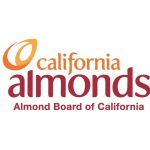 Pending Endangered Listings: What Growers Need to Know
Pending Endangered Listings: What Growers Need to Know
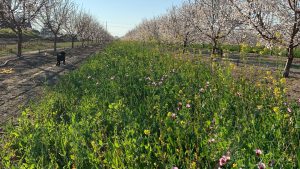
Two pending endangered species listings for pollinators can have major impacts on the almond industry as many almond growers have added pollinator forage such as blooming cover crops, hedgerows and floral strips to add value to their operation. Josette Lewis, Almond Board of California chief scientific officer, said 2023 will be a decisive year for the endangered listing of the monarch butterfly and native bees in California, which leads to questions for growers. However, work is underway to protect producers if this happens and Lewis took some time to answer those questions.
Q – What is the status of the monarch butterfly being listed as an endangered species?
Lewis – A couple of years ago, the U.S. Fish and Wildlife Service made the decision that monarch butterflies were warranted as an endangered species, but they had other priorities at the time. So, while it was not going to be listed, they are required by law to revisit that decision by the end of this calendar year.
Q – If they do get listed as endangered, what does that mean for an almond grower?
Lewis – It means a couple of things:
The first is that a lot of almond growers have stepped up and added pollinator forage, flower resources and habitat to their farms and land around their farms. We’ve seen a great response in terms of the number of growers who have registered as Bee Friendly Farms, who are putting in flowering cover crops, and working with organizations like Monarch Joint Venture to specifically put in monarch habitat around their ranches. Several handlers are working with growers on pollinator habitat too, as it has value to some almond buyers.
For those growers who have stepped up, we want to make sure that they are protected if the monarch is listed as an endangered species. So, if they accidentally harm the caterpillars or the butterflies themselves, we want to make sure that they are not breaking the law because they’ve done such a good job of adding that forage into their operation.
The other issue, on an industry level, is that the U.S. Environmental Protection Agency – who has to approve every crop production product our industry can use – was also mandated by law to increase their review of the potential negative impacts of pesticides on endangered species.
We know that if the monarch is listed, some of the products we use when they come up for re-registration, or any new products that are developed and need to be registered, will have extra scrutiny for their potential impact and could involve more restrictions on the use of those products.
Q – So it sounds like this could be a legal concern for growers and a bigger concern of more regulation on certain products if the monarch gets listed as endangered. What is ABC doing to address these two concerns?
Lewis – We’ve been working with the Almond Alliance of California, other California agricultural interest groups, and some conservation groups who have been valuable partners of the California almond industry to negotiate a conservation agreement with the U.S. Fish and Wildlife Service that would protect growers who have monarch habitat if they accidentally harm any of those monarch butterflies or larvae.
The way those agreements work is that we have to show that there’s a net benefit to the pollinators. Things like adding flowers and habitat for monarch butterflies, and in exchange for doing those good things, in this agreement you’re then protected if you accidentally harm monarchs.
Also, as part of those negotiations, we are including the kind of practices that reduce risks of crop protection products and try to demonstrate that we can use those safely and still have a net benefit to monarch butterflies.
Q – “Net benefit” seems like the important term in this conversation. ABC grower-funded research has already been completed in this realm and showed pollinator gains from increased habitat outweighs the risk. Can you explain that?
Lewis – That’s right. ABC funded research with a native bee expert at UC Davis, which was published last year, showed that when farmers add floral strips – such as wildflower strips, part of a hedge row or just wildflowers near the outside the orchard – the added food for native bees helps protect those bees from the impacts of pesticide exposure. So, there is a net benefit to those native bees.
This research provides good, peer-reviewed and science-based evidence that shows these kinds of activities we have seen many growers in our industry do have a net benefit.
Q – ABC and partners are already addressing these concerns, which is good because more and more growers and handlers are utilizing this practice, right?
Lewis – A lot of growers have been looking at cover crop and adding that into their orchard management. This year in particular, I heard a grower who planted cover crops talk about how the water didn’t stay standing in their orchards back in early spring when we had so much rain, rather that the water infiltrated and drained much more quickly.
There are agronomic benefits from the practice that are worth considering, in addition to benefits to pollinators. And adding more permanent habitat outside the orchard is another area where a number of our handlers in the industry have seen a market value. Buyers want to know that they have a supply chain of almonds that allows biodiversity and a healthy ecosystem on the farm. Some handlers have really leaned in with their growers and are encouraging those kinds of practices, and that’s added certain value to both growers and handlers.
We are here to share current happenings in the bee industry. Bee Culture gathers and shares articles published by outside sources. For more information about this specific article, please visit the original publish source: Pending Endangered Listings: What Growers Need to Know (almonds.com)
]]>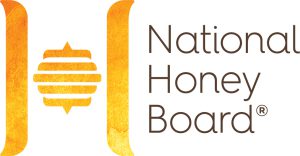 National Honey Board shares Pollinator Week Tips
National Honey Board shares Pollinator Week Tips
Source: National Honey Board
By Brian Amick
Honey bees are responsible for a third of the food we consume as Americans, thanks to their ability to pollinate some of our favorite fruit, vegetables and nuts. These efforts are celebrated during Pollinator Week, which runs from June 19-25.
“Honey bees in particular are powerhouse pollinators and getting involved in protecting their habitats — down to supporting healthy ecosystems — is something we can all do not only during Pollinator Week, but year round,” says Catherine Barry, the National Honey Board’s director of marketing. “The food and beverage industry would be quite bland without honey bees, as they are responsible for pollinating many of the ingredients used in some of the biggest food brands in the world.
Here are five ways to celebrate honey bees and other pollinators, according to the National Honey Board:
- Plant native plants: Native plants are better adapted to the local climate and soil, making them easier to grow and maintain. They also provide the best food and habitat for pollinators.
- Plant flowers with different bloom times: Pollinators need a diverse range of flowers to meet their nutritional needs throughout the growing season. Plant a variety of flowers that bloom at different times of the year to ensure a steady supply of nectar and pollen for pollinators.
- Create habitat: Pollinators need a place to rest and nest in between feeding. Create habitat in your garden by leaving some areas wild and adding features such as brush piles to provide shelter for pollinators.
- Avoid using pesticides: Pesticides can be harmful to pollinators and can disrupt the natural ecosystem in your garden. Instead, use natural pest control methods such as companion planting or handpicking pests to keep your garden healthy and free of harmful chemicals.
- Provide water: Pollinators need water to drink and to regulate their body temperature. Provide a shallow dish or birdbath filled with water to give pollinators a place to drink and cool off on hot days.
Those who want to learn more about the essential role honey bees and beekeepers play in the food industry and pollination can visit the National Honey Board’s website or watch its Celebrating Beekeeping video series.
We are here to share current happenings in the bee industry. Bee Culture gathers and shares articles published by outside sources. For more information about this specific article, please visit the original publish source: National Honey Board shares Pollinator Week tips | Bake Magazine
]]>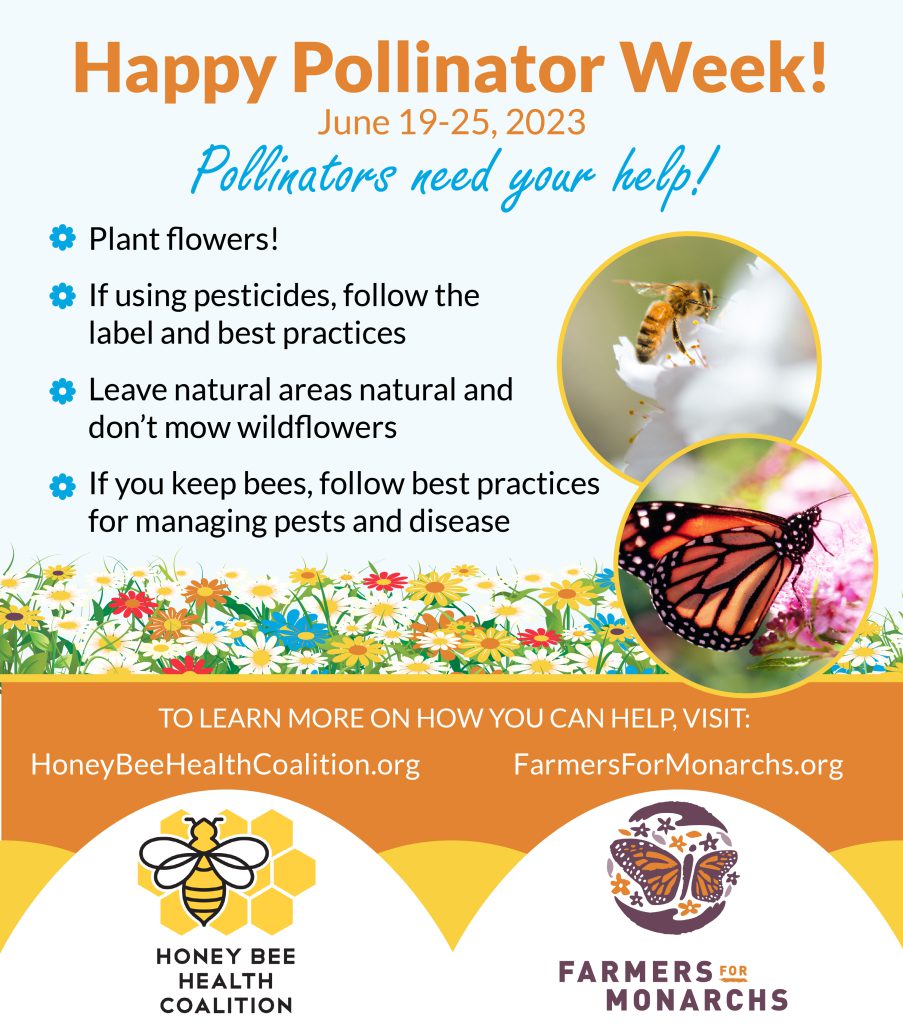
Links:
Honey Bee Health Coalition: https://honeybeehealthcoalition.org/
Farmers for Monarchs: https://farmersformonarchs.org/
]]>
By Bhavana Kunkalikar Reviewed by Lily Ramsey, LLM
In a recent study published in the Nutrients journal, researchers evaluated using bee pollen as a nutrient source. The study focused on understanding bee pollens’ nutrient richness and possible role in the pathophysiological mechanisms linked to imbalanced nutrient levels.
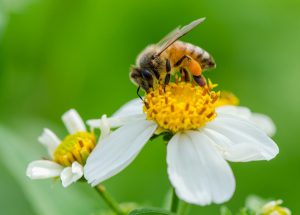
Study: Translational Research on Bee Pollen as a Source of Nutrients: A Scoping Review from Bench to Real World. Image Credit: TippaPatt/Shutterstock.com
Background
Healthy nutrition is becoming increasingly important in the field of biomedical sciences. The role of nutritional deficiencies and imbalances in causing global public health issues, including cardiovascular and metabolic diseases, has been extensively proven.
Bee pollen has been identified as a potential aid in reducing health issues through nutritional interventions. Bee pollen is currently under extensive study and is a highly nutritious and well-balanced source of nutrients.
About the study
In the present study, researchers explored evidence supporting bee pollen (BP) usage as a nutrient source.
A scoping review was conducted to evaluate the existing evidence on the nutritional benefits of BP in both standard and pathophysiological environments. The team employed available data to assess the evidence, identify areas lacking knowledge, and create recommendations for future study.
Effective strategies have been developed, and efforts have been made to establish standards for framing, normalizing, and reporting conditions and achievements.
The Preferred Reporting Items for Systematic Reviews and Meta-Analysis Extension for Scoping Reviews (PRISMA-ScR) guidelines checklist, which was developed based on the Enhancing the Quality and Transparency of health research (EQUATOR) group’s approaches and released in 2018, is one of the recommended guidelines for systematic reviews and meta-analyses.
The focus was primarily on publications released within the past four years. The initial literature research revealed that there was repetition among bioactivity-related parameters studied for BP. Two previous general reviews involving BP were published before 2020.
Scientific data for analysis were gathered from various international databases specializing in medical and pharmaceutical fields, including PubMed, Scopus, ScienceDirect, Cochrane Library, Web of Science, and Google Scholar. The team initially searched using the term “bee pollen” to identify relevant publications.
Results
The team found that BP is a nutrient-rich food source containing proteins, minerals, vitamins, unsaturated fatty acids, and oligo-elements. It is also low in calories and generally well-tolerated and safe, except for the possibility of allergic responses or external pollution, which can be managed and predicted.
Hazards associated with BP can result from external contamination, which can significantly impact pollen due to its sensitivity or from unfavorable storage and processing conditions.
Documenting pollen composition and considering patient sensitivity can prevent allergic responses to the product. Additionally, BP is safe for most physiological situations, including among children, the elderly, and recovering patients. BP is a valuable source of essential elements for pregnant and breastfeeding women.
A study of 27 commercial BP samples found that consuming 40 g of the product daily while breastfeeding can provide a significant portion of daily copper, manganese, iron, and selenium needs.
A review of over 100 published studies found that the primary components of BP, listed in order of weight or weight importance, are carbohydrates, lipids, proteins, ash, fibers, and other elements. The presence of polyols in the carbohydrate matrix contributes to its lower caloric value and helps maintain a balanced intake of energy sources and other nutrients.
BP’s rich composition makes it ideal for human nutrition, as it can help rebalance or prevent various nutritional deficiencies along with pathophysiological conditions.
The most extensively researched characteristic of BP is its antioxidant activity. Furthermore, the significance of BP usage lies in its potential as an anti-inflammatory agent.
The activity of bee pollen composition varies greatly depending on various factors such as plant and bee species, geographical region, timing, soil type, processing, and environmental conditions. Comparative studies have found that multi-floral pollens have stronger antioxidant activity than mono-floral pollens.
BP has significant anti-inflammatory effects on various types of inflammation, such as localized and systemic forms like digestive wall inflammations and neuroinflammation.
BP’s anti-inflammatory potential has been extensively researched, with different experimental studies highlighting various mechanisms.
The anti-inflammatory phytochemicals found in BP, including polyphenols, as well as other phytonutrients such as peptides, lipids, polysaccharides, and other compounds, have been linked to these activities.
Additionally, the team noted that the anti-inflammatory activity of BP varies based on bee species, in addition to differences based on botanical origin.
Conclusion
Overall, the study findings suggested that addressing the gaps identified in their study is crucial for improving research on BP.
The researchers recommend utilizing high-throughput technologies like omics sciences and computational-based simulation techniques to analyze the vast and diverse data.
Journal reference:
- Kacemi, R. and Campos, M. (2023) “Translational Research on Bee Pollen as a Source of Nutrients: A Scoping Review from Bench to Real World”, Nutrients, 15(10), p. 2413. doi: 10.3390/nu15102413. https://www.mdpi.com/2072-6643/15/10/2413
We are here to share current happenings in the bee industry. Bee Culture gathers and shares articles published by outside sources. For more information about this specific article, please visit the original publish source: Use of bee pollen as a nutrient source (news-medical.net)
]]>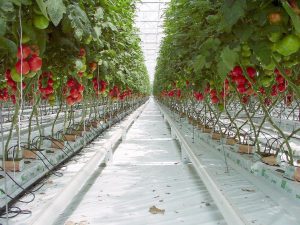
With the ‘bombus bee’ project of the Ministry of Agriculture and Forestry, in Turkey, bombus bees are produced under laboratory conditions. These bees ensure the fertilization of the products grown in greenhouses without the use of hormones and increase the yield. Bombus bees will increase the yield and quality by ensuring the hormone-free growth of eggplant, pepper, and other vegetables, especially tomatoes. It is also important for products such as melons and strawberries. While greenhouse cultivation is carried out on 81.000 hectares in Turkey, it is estimated that this area will expand with increasing momentum due to reasons such as global warming, population growth, and price stability. Bombus bees constitute the most important group after honey bees in the pollination of plants and are widely used, especially in greenhouse cultivation. While 600,000 of bombus bee families were sold in the country in the 2022-2023 season, the price for March 2023 was determined as 27 USD per colony. While greenhouse cultivation in Turkey is carried out in large areas in the Mediterranean and Aegean regions, the Directorate of Beekeeping Research Institute, which is the only beekeeping central unit of Turkey, evaluates the project activities carried out by growers. It has been determined that the use of bombus bees in greenhouses in the Black Sea Region was not common, especially in the pollination in tomato cultivation.
Thereupon, the project ‘Determination of Colony Characteristics and Suitability for Mass Production of Bombus Population in the Central Black Sea Coast Region’ was developed by the General Directorate of Agricultural Research and Policies (TAGEM). Within the scope of the project, the ‘Bombus Research and Application Laboratory’ was established in order to meet the needs of the sector and to ensure the commercialization potential of local bombus bee resources. The production of bombus bees in the laboratory environment started at the beginning of 2023. Bombus bees produced in the laboratory will be used in greenhouses in the provinces of the Black Sea Region. Within the scope of the studies carried out for the production of bombus bees, known as the ‘natural workers’ of the greenhouses, many colonies were obtained by enabling the ‘bombus terrestris’ breed queens to reproduce in the special climatization room created within the institute.
While bombus bees produced in the laboratory ensure the growth of eggplant, pepper, and other vegetables, especially tomatoes grown in greenhouses in the provinces of the Black Sea Region, without using hormones, it is aimed to increase the yield and quality of the products without disturbing the balance of nature. Thanks to bombus bees, which are used to help fertilize vegetables in greenhouse cultivation, labor costs are also reduced. A bombus bee visits 4,800 flowers in one day during its foraging activities.
We are here to share current happenings in the bee industry. Bee Culture gathers and shares articles published by outside sources. For more information about this specific article, please visit the original publish source: Bombus bees are produced in laboratories to be used in greenhouses (hortidaily.com)
]]>$15K grant supports local efforts in eastern Kansas
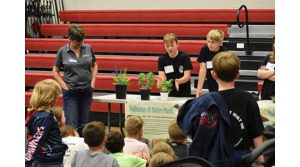
Kansas teens are learning how to plan, plant and maintain habitats that attract butterflies, bees and other pollinators. (Photo courtesy of Cheri Nelsen, Wildcat Extension District)
MANHATTAN, Kan. – An ambitious group of teenagers have set out on a path to improve pollinator habitat in their communities, while giving a nod to the important role that bees and butterflies play in food production.
Cheri Nelsen, a 4-H youth development agent in K-State Research and Extension’s Wildcat District, said the teens are learning how to plan, plant and maintain habitats that attract pollinators.
“Many youth know about pollinators like bees and butterflies, but they don’t always know what is needed for attracting and keeping pollinators,” Nelsen said.
Earlier this year, Nelsen and Leavenworth County extension agent Sonya Murphy were awarded a $15,000 grant from the National 4-H Council and Corteva Agriscience to support community-based pollinator projects.
The group includes youth from the Wildcat District – which includes Crawford, Labette, Montgomery and Wilson counties in southeast Kansas – and Leavenworth County (northeast Kansas). Nelsen said 17 youth have received initial training for teaching others; each of those youth is charged with teaching an additional 250 youth about pollinator habitats.
National wildlife conservation officials have put recent emphasis on creating habitat that attracts pollinators. As an example, in mid-2022, the iconic monarch butterfly – known for its bright orange and black markings – was placed on the endangered list, a result of habitat destruction and climate change, among other reasons.
As they move about, pollinators often choose milkweed to lay eggs.
“Maintaining a healthy habitat is important for pollinators,” Nelsen said. In nature, bees, butterflies and other pollinators carry pollen from the male part of a flower (known as the stamen) to the female part of the same or another flower.
Nelsen adds: “We all need to eat, and pollinators also play a vital role in food production (by pollinating food crops). For myself, I enjoy watching kids learn new things and doing things to help the community.”
In Parsons, youth are planting a seven acre plot to native plants. Nelsen said part of the process is determining what type of pollinator plants need to be included.
In Leavenworth County, youth are planning a pollinator garden at the Veteran’s Administration hospital.
Nelsen said youth have also taught lessons at Earth Day and in local schools, and are planning events during the upcoming county fair season.
We are here to share current happenings in the bee industry. Bee Culture gathers and shares articles published by outside sources. For more information about this specific article, please visit the original publish source: 4-H Youth Launch Projects to Improve Pollinator Habitat | Morning Ag Clips
]]>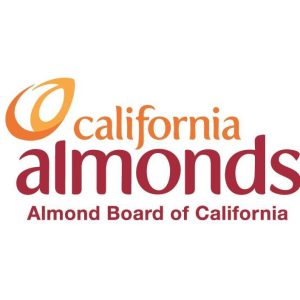 USDA Forecasts Smaller Almond Crop
USDA Forecasts Smaller Almond Crop
Harvest 2023 expected to be down 3 percent from last year after a stormy bloom.
MODESTO, Calif. – The 2023 California Almond Subjective Forecast published Friday by the U. S. Department of Agriculture’s National Agricultural Statistics Service (USDA-NASS) estimates that the crop harvested in 2023 will come in at 2.50 billion pounds, 3 percent below last year’s 2.57 billion pounds.
Forecasted yield is 1,810 pounds per acre, down 90 pounds from 2022 and the lowest since 2005.
“A lower crop estimate was not unexpected considering all that growers dealt with last year and during this year’s bloom,” said Richard Waycott, president and CEO of the Almond Board of California (ABC). “The cold, wet weather kept bees in their hives and reduced the hours they could pollinate orchards. In the past three years, growers have faced high costs, shipping issues, drought and more. But the water picture is better, at least for this year, shipping continues at record levels and global demand continues to grow. California’s almond farmers are prepared to meet that global demand.”
The report said: “Record rainfall and unprecedented stormy conditions impacted pollination. Limited bee flight hours were reported in all growing regions. There were reports of downed trees due to high winds and oversaturated soil. Yields are expected to be the lowest in years, with variation observed across varieties and orchard locations. Colder than normal temperatures continued through March and April, resulting in a delayed crop.”
The Subjective Forecast is the first of two production reports from USDA-NASS for the coming crop year. It is an estimate based on opinions from a survey conducted from April 19 to May 6 of 500 randomly selected California almond growers. The sample of growers, which changes every year, is spread across regions and different sized operations, and they had the option to report their data by mail, online or phone.
On July 7, USDA-NASS will release its second production estimate, the 2023 California Almond Objective Report, which is based on actual almond counts in nearly 1,000 orchards using a more statistically rigorous methodology to determine yield.
This Subjective Forecast comes two weeks after USDA-NASS released the 2022 California Almond Acreage Report which found total almond acreage had dropped in 2022 to 1.63 million, 1.2 percent down from 1.65 million in 2021. It also estimated 1.38 million bearing acres in 2023, up from 2022’s estimate of 1.35 million bearing acres.
USDA-NASS conducts the annual Subjective Forecast, Objective Report and Acreage Report to provide the California almond industry with the data needed to make informed business decisions. These reports are the official industry crop estimates.
For More Information
Rick Kushman
Media Relations Manager
Almond Board of California
[email protected]
(916) 716-9900
We are here to share current happenings in the bee industry. Bee Culture gathers and shares articles published by outside sources. For more information about this specific article, please visit the original publish source: USDA Forecasts Smaller Almond Crop (almonds.com)
]]>